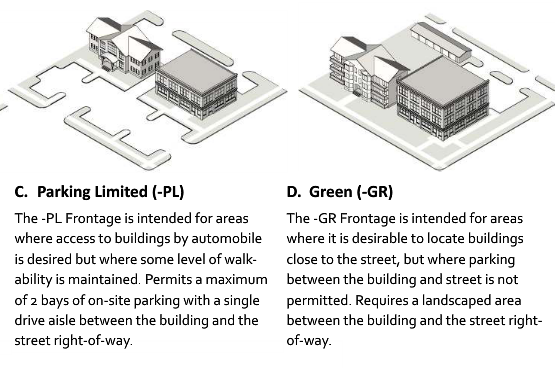Frontages, a planner term for how buildings address the street, are already starting to cause debate among City Councilors and developers.
Frontages are a major part of the city’s new zoning code, and were a sticking point during Wednesday’s Comprehensive Planning Committee meeting, when members discussed a rezoning request for DHIC’s latest affordable housing project on Tryon Road.
The new Unified Development Ordinance (UDO) uses frontages as a way to bring a consistent design or form to a particular area.

David Brown, a landscape architect from JDavis Architects, said the rezoning request asked for a Parking Limited frontage because it provided an option to save fewer trees in the front of the property and more trees in the back, increasing the buffer between the new development and an existing neighborhood.
Councilor Thomas Crowder said he thought a green frontage was more appropriate for the area. A green frontage would require more trees along the street, which he said is consistent for that part of Tryon Road. A green frontage would also prohibit parking in front of the building.
In comparison, Parking Limited would allow parking along the street.
Both Brown and DHIC’s attorney, Isabel Mattox, offered a condition that would legally prohibit parking between the building and the street, which they said would accomplish the same goal as the alternative frontage.
While that may be the case, Crowder said that if the case were approved, it would set a precedent for other future development in the area.
“I don’t want to set a precedent for Parking Limited on Tryon Road whether it’s perceived or otherwise,” he said.
Issues with Timing and Public Notice
The UDO also changed when rezoning cases are heard at public hearings. Previously, public hearings were held before the case was sent to Planning Commission for review. Now, the Planning Commission review comes first. A public hearing is scheduled after Commissioners make their recommendation.
Councilors can then approve or deny the request, or hold it for additional discussion.
The public hearing for this project is slated for June 3.
Crowder asked that DHIC come back with an amended rezoning application with the preferred frontage, which would have to be done within 24 hours in order to be ready for public hearing.
Deputy City Attorney Ira Botvinick pointed out that although amending the rezoning application to include a different, more restrictive frontage can be done from a legal standpoint, the original frontage was advertised in the public hearing notice.
Botvinick said that a change can be done, but it comes with a lot of confusion.
“The world believes we’re going to public hearing with Parking Limited,” he said.
Mattox said that their original condition could be added quickly and didn’t want to make a change to the zoning request. She and Brown agreed to consider the change and let staff know within 24 hours.
Transit Easement Change
Residents in the nearby Camden Crossing neighborhood expressed concerns with a proposed transit easement on Trailwood Hills Drive.
Andy Petesch, an attorney representing the neighborhood, said today there are two bus stops directly across from each other. Because both are the start and end points for the route, the buses often idle as they get back on schedule. Both are often there at the same time, he said, obstructing the view of the road.
Depending on where transit staff decide the bus stop should be located, it could make the problem worse, he said.
Crowder suggested removing the transit easement from Trailwood Hills Drive and locating it on Tryon Road instead.
Mattox said they aren’t necessarily opposed to that, but, “Staff had said strongly that they want it on Trailwood Hills.”
Councilor and committee member Bonner Gaylord said he wasn’t in favor of relocating the easement without knowing the impacts.
“I think that staff made that recommendation for a reason and I want to hear that before I issue a contrary,” said Gaylord.
Transit staff were not at the meeting.
A compromise was reached by removing Trailwood Hills Drive from the condition, which would let transit staff determine the best location — either Trailwood Hills Drive or Tyon Road — during the site plan stage of development.
